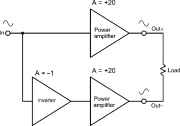- Joined
- Jan 14, 2011
- Messages
- 75,632
- Location
- Gillette, Wyo.
- Tagline
- Halfbiass...Electron Herder and Backass Woof
Off-shore???
that not how it works. A little more google search Peter is requiredSo here is the manual I bought in 1979 for my first PL, a 700. It suggests installing 8 amp fuses for "Industrial or PA use" I now see a spec for power into 4 ohms.
About Bridging, I am driving the amplifiers with a miniDSP 4 x10 HD. The DSP functions as pre amp, EQ, and Crossover. It has unbalanced RCA as well as balanced outputs with up to 8 V RMS. Could I connect two series resistors (maybe 1 k ohms each?) across the +and - balanced output, then ground the centre point to the PL input ground. The + side of the resitor string would drive one channel, the - side would drive the other.
Voila! Amplifier is bridged! Am I missing something?
Again that is not how to make it work from the opposite side. The 700b meters are special built. You can custom order one from the meter manufacturers but it’s going to cost you.Trying to be 'PC'---made in China. Next question would be; Is there enough adjustment to move the pointer to the other side of the scale? Most meters are 'righside up'

I think there’s an issue of any meter meeting a certain specification for current handling, so they’re not fully compatible. I believe the spec was “ohms per volt” that determined how far a meter would deflect compared to the amount of voltage applied or current going through. Even if you mechanically “zero” the pointer, you would get a false reading, either too high or too low.Has anyone considered fitting an 'off shore' movement into the case of a damaged meter?
Does it matter whether the amp is quasi- or full- complimentary?Wish you well Peter
your setup is unlike phase linear s idea back in the day.View attachment 50348
Nice speakers. Note that JBL is very conservative in their power handling specifications. I have never seen an equivalent speaker take more power than a JBL.1.5 db less efficient but approx 3 db more power handling,
And the power supply capacitors you would find at an estate sale...seems like bad news
